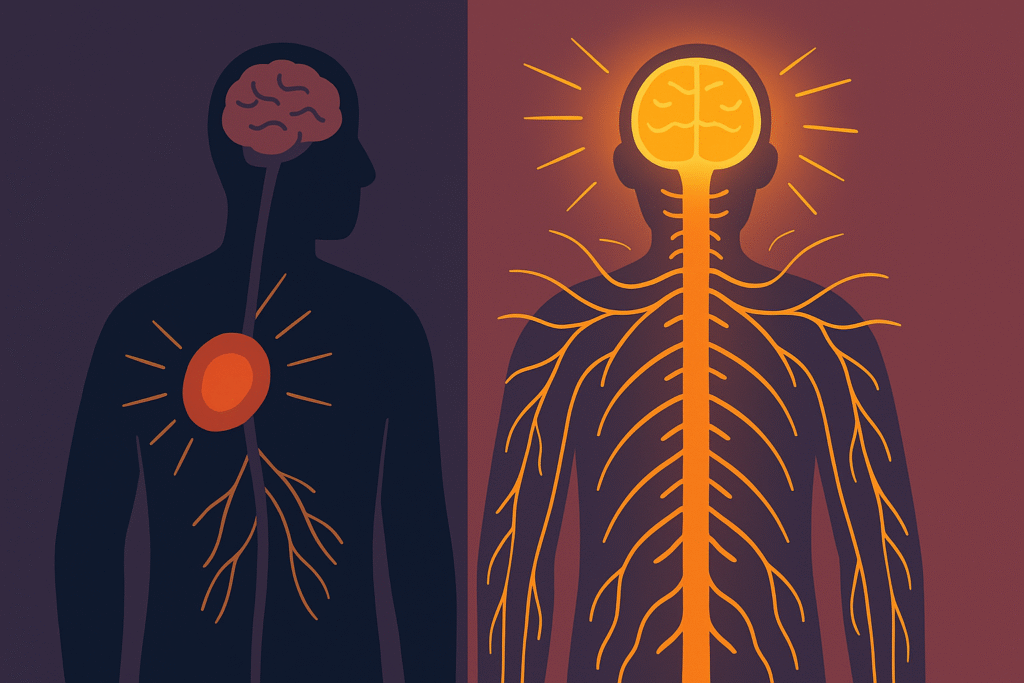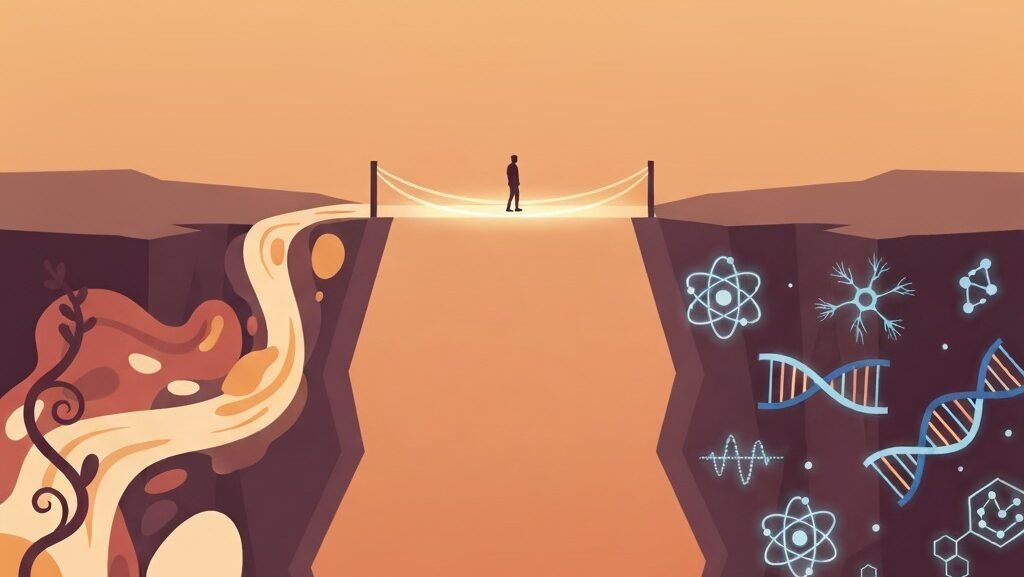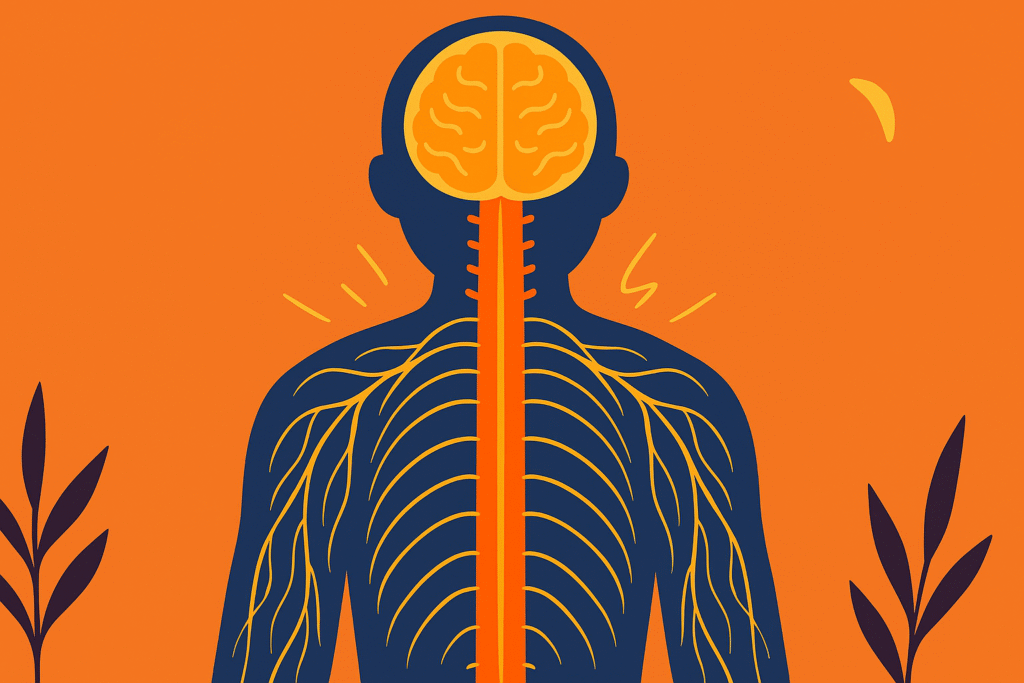When Pain Doesn’t Match the Scans
“Why”, won the award for the most used word in my last three years. I was using it alone in my bed at night, in professionals’ offices and while staring at my scans. I feverishly searched my past, trying to find another time when the pain refused to leave, a different instance when everything looked fine but was not fine at all.
The answer to all of this “investigation” was clear: in the past, the pain had always left. Now I felt as vulnerable as a petal. Everything seemed to amplify the sensation of pain. I could not properly plan or concentrate, and I gave up on anything I remotely considered might worsen my health problem. As a result, isolation quickly followed. As we say in Romania, when things go from bad to worse, “I was falling from a lake into a well.” People around me also started asking: “How is it possible that from a ‘stuck’ episode, you got here? What is it? Why is it not going away?” So, I was not the only one asking these questions. I had no answer for them. All I knew was that it was spreading, it was burning, it was hurting in ways hard to describe. And when someone asked me to localize it, I simply included my entire back, neck and head, because this is how far it was reaching. During the flares, the pain even spread down towards my elbows and knees.
I was very sensitive too. I was never someone who enjoyed a hand passing through my hair, but now even the gentlest touch on my scalp sent me to Nirvana. Yet even a little more pressure during a massage sent me straight to hell.
Why?
After three years, I finally received the answer to my unexplained pain symptoms: central sensitization. This was the moment my chronic pain journey took a new turn, and I finally began finding answers to all the lingering whys.
(Note: Central sensitization is not a diagnosis itself, but a mechanism. It means the brain and spinal cord become extra sensitive to pain signals – so they feel more intense, last longer and spread beyond the original area.)

Sensitization vs Central Sensitization: What They Mean and Why They Matter in Chronic Pain
Understanding the difference between sensitization and central sensitization is key to managing chronic pain. We will start with a simple analogy:
- Sensitization is like a car alarm triggered when someone touches the car.
- Central sensitization is like the same alarm blaring nonstop, even when nothing is happening – the entire system is stuck on high alert.
Sensitization (General)
Definition: An increased response to a stimulus after repeated exposure.
Where it happens: Sensitization can occur anywhere in the nervous system – in the peripheral nerves (near the site of injury) or in the central nervous system (from now on, CNS).
Example: Imagine you have a sunburn. Even the lightest touch on your skin hurts more than usual. This is peripheral sensitization – the nerves in your skin have become more sensitive after injury.
Central Sensitization
Definition: A specific type of sensitization that happens in the central nervous system (the spinal cord and brain).
What happens: The CNS acts like a volume knob stuck on high. Normal pain signals get amplified, pain feels stronger and lasts longer, spreads further than you would expect or even appears without a clear injury.
Example: After a simple lower back strain – the most common cause of chronic pain – instead of the pain fading as expected, it continues for months or years. It doesn’t just stay in one spot; it can spread to the back, neck, head or even the arms and legs. This is not just the injured area being sensitive; it’s the entire pain-processing system amplifying signals.
But in central sensitization, the alarm system doesn’t switch off. Instead, the brain and spinal cord keep amplifying pain signals, even when the original injury has improved.
Causes of Central Sensitization: Why It Happens and What Triggers It
Central sensitization doesn’t appear out of nowhere – it usually follows a mix of physical and emotional experiences.
Injury or medical procedures: A back injury, surgery or even injections into the spine can act as a trigger. What should have healed normally sometimes leaves the nervous system stuck in a state of ongoing alert.
Stress and trauma: Both past and current stress can train the nervous system to stay on high alert. Early life adversity or repeated invalidation by doctors and people close to you can keep the body in a state of constant defence.
Ongoing pain signals: If symptoms continue for months, the nervous system adapts by becoming more sensitive instead of calming down. That is why discomfort can spread beyond the original injury site.
In simple terms, central sensitization happens when the body and brain decide: “You are in danger – I must keep warning you.” The challenge is that the warning system stays active, even when the danger has passed.

Central Sensitization Symptoms Explained: From Real-Life Story to Science
Dear reader, these are some of the most common central sensitization symptoms I experienced, expressed in everyday language and translated into science. It is very important to be able to name whatever happens to your body and your mind. I call it – and you can too – validation.
Pain Spreading Beyond the Original Injury
→ My pain started in the lower back but soon spread to my whole back, neck and head, reaching the elbows and knees.
Scientific terms: Central amplification – the nervous system “turns up the volume” and discomfort spreads beyond the original site of injury.
Pain Intensity Influenced by Emotions and Stress
→ Stress, anxiety and even lack of sleep made the symptoms worse.
Scientific terms: Stress-induced hyperalgesia – stress and negative emotions can increase sensitivity. But how does anxiety sensitize the nervous system? Find the answer here.
Burning Sensations
→ A feeling of burning under my skin.
Scientific terms: Dysesthesia – unpleasant, abnormal sensations (often burning) caused by changes in the nervous system.
Neuropathic-Like Symptoms (With or Without Nerve Injury)
→ Electric shocks, pulsating sensations and the feeling of “stepping on snakes that bit me.”
Scientific terms: Often, neuropathic pain links to the above symptoms, but they can also appear without nerve injury when central sensitization is present. If both are present, central sensitization amplifies and spreads the signals beyond the original site.
Sensitivity to Postures and Touch
→ After 15 minutes in the same position, I had to move because of the pain.
Scientific terms: Allodynia (pain from normally non-painful touch) and hyperalgesia (exaggerated response to mildly painful stimuli).
Sleep Disruption and Fatigue
→ Pain kept me from sleeping, no matter how many pillows or changes I made.
Scientific term: Non-restorative sleep – strongly linked with central sensitization, because poor sleep lowers thresholds and increases sensitivity.
Brain Fog and Cognitive Symptoms
→ I felt foggy and drained.
Scientific terms: Cognitive dysfunction (often called “fibro-fog” in fibromyalgia) – difficulties with concentration and memory that are frequently linked to central sensitization.
Emotional Amplification of Pain
→ Every time I felt invalidated or dismissed by doctors or other people, the symptoms grew worse.
Scientific terms: Emotional modulation of pain – emotions directly influence how strongly the brain perceives discomfort. Negative emotions can heighten it, while positive emotions can dampen it.
Hypervigilance and Safety Behaviours
→ I was always checking if the chairs were comfortable, weighing the possibility of leaving whenever I needed to and fearing that people might not understand.
Scientific terms: Pain-related hypervigilance – constant monitoring of the body and environment because of fear of symptoms, often linked with worse outcomes.

Can Central Sensitization Be Reversed?
The best news I have received is that central sensitization is not permanent. The nervous system is changeable – scientists call this neuroplasticity. Just as the brain and spinal cord can “learn” to turn the pain volume up, they can also learn to turn it back down.
Recovery from central sensitization doesn’t happen overnight, but it is possible. Education itself is powerful: when you understand why your pain feels bigger than your scans show, fear eases and a sense of relief follows.
So, if you’re wondering, “Can central sensitization improve?” the answer is yes. Progress may be slow, but with the right support, the nervous system can recover and pain can ease.
Never has “less is more” made more sense to me than in chronic pain because of central sensitization. Sometimes the smallest steps – gentle movement, calming the mind or simply resting – are what help the nervous system find safety again.
Central Sensitization Recovery: What Really Helps
These habits can help your body and mind shift out of constant alert and find more calm.
Pace your activity: don’t push until you crash. Do a little, take a break before exhaustion sets in, then add more gradually
Gentle movement: walking, stretching, yoga or light exercise helps retrain the body to feel that movement is safe
Better sleep hygiene: go to bed at regular times, limit screens and create a restful sleep environment
Breathing exercises: slow, deep breathing signals safety to the brain
Mindfulness and meditation: short daily practices calm the brain’s alarm system and reduce stress
Relaxation practices: listening to calming music, progressive muscle relaxation and guided imagery
Education about pain: understanding that pain doesn’t always equal harm, reduces fear and lowers sensitivity
Journaling and self-reflection: writing down your thoughts and tracking symptoms can lower anxiety and reveal progress
Positive imagery and visualization: imagine safe, pleasant scenarios to help the system shift out of danger mode
Connecting with supportive people: being believed and supported reduces stress and helps the brain feel safe
Therapeutic approaches: cognitive-behavioural strategies; working with a physiotherapist can retrain pain pathways
Gentle exposure to triggers: gradually facing feared movements or situations helps the body relearn safety
Nutrition basics: eating balanced meals, staying hydrated and avoiding too much caffeine or alcohol — improve overall regulation
Self-compassion: speaking kindly to yourself reduces the emotional load that fuels pain.
The Good News
Neuroplasticity and pain recovery → the brain can relearn safety and reduce pain signals
Central sensitization recovery is possible at any age
Living with central sensitization gets easier with small daily steps
Managing chronic pain doesn’t have to be expensive – many tools are free or low-cost
You’re not alone – support, information and communities are more accessible than ever.

Myths and Misconceptions About Central Sensitization
“It’s all in your head.”
→ No, it’s in the nervous system. Central sensitization is a real, measurable process in the brain and spinal cord that amplifies pain signals. If you feel pain, then it is real.
“If nothing shows on scans, you’re fine.”
→ Not true. Scans show structure, not function. Central sensitization can cause severe chronic pain even when MRIs or X-rays look normal.
“Pain always means damage.”
→ Not in chronic pain. With central sensitization, pain continues long after tissues have healed. The nervous system keeps sending alarm signals even without a recent injury.
“You just need stronger medication.”
→ Medication alone often isn’t enough. Central sensitization responds better to a mix of education, gentle movement, sleep regulation and strategies that calm the nervous system.
“You have to push through the pain to get better.”
→ Pushing too hard can make things worse. Pacing – balancing activity and rest – helps the nervous system relearn safety without overload.
“Recovery isn’t possible.”
→ False. Thanks to neuroplasticity, the nervous system can change. Many people reduce pain and reclaim quality of life with the right strategies.
Here’s the one thing I want you to remember: you don’t have to fix everything at once. Sometimes the most powerful step is simply knowing there is an explanation for your pain. The rest can follow, one day at a time.
In my next article, I’ll talk about the fear-pain connection in nervous system dysregulation and simple ways to assure your body that it’s safe again. Stay curious and be kind to yourself!
If you got this far,
Get Support in Your Inbox
Subscribe to the newsletter and let me help you turn confusion into clarity. The PDF I have prepared is a guide that will help you organise all the elements of your condition: symptoms, treatments and impact, so you can understand your pain behaviour. This is truly important when it comes to explaining it to healthcare professionals, loved ones and yourself.
“Clinical Clarity Workbook – A map for precise diagnosis“
Until next time,
Alina

